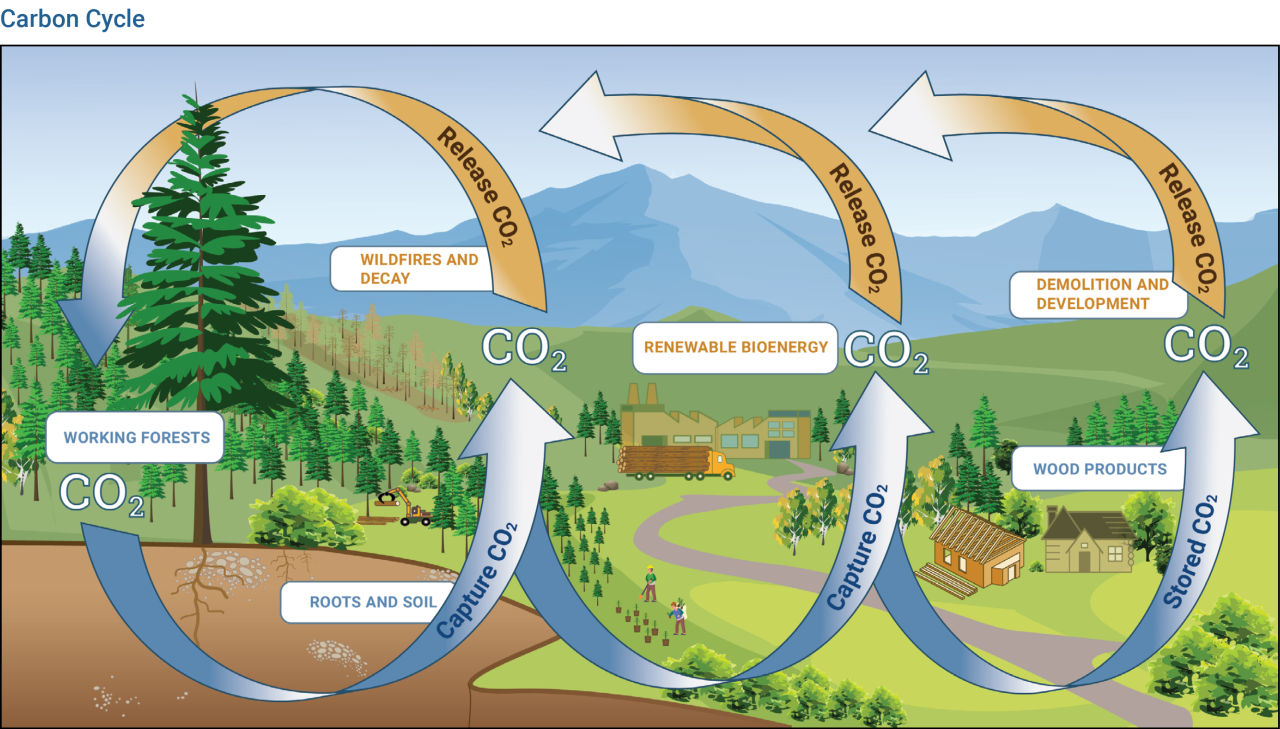PotlatchDeltic: Forests and the Carbon Cycle
PotlatchDeltic explains how sustainably managed forests help combat climate change through carbon management. Trees absorb CO2 and store carbon in their structure, while wood products act as 'carbon vaults'. Active forest management enhances carbon removal compared to unmanaged forests, with 68% of carbon in sawtimber transported to mills and 32% remaining on site. Wood products manufacturing stores about 55% of wood carbon, while residuals are used for additional products or biogenic energy. The cycle of planting, growth, and harvest creates cumulative carbon storage over time. U.S. forests, harvested wood products, and urban trees offset more than 11% of total GHG emissions annually.
PotlatchDeltic spiega come le foreste gestite in modo sostenibile contribuiscono a combattere il cambiamento climatico attraverso la gestione del carbonio. Gli alberi assorbono CO2 e immagazzinano carbonio nella loro struttura, mentre i prodotti in legno fungono da 'vaults di carbonio'. La gestione attiva delle foreste migliora la rimozione del carbonio rispetto alle foreste non gestite, con il 68% del carbonio nel legname da segare trasportato ai mulini e il 32% che rimane sul posto. La produzione di prodotti in legno immagazzina circa il 55% del carbonio del legno, mentre i residui vengono utilizzati per ulteriori prodotti o energia biogenica. Il ciclo di piantagione, crescita e raccolto crea un accumulo di carbonio nel tempo. Le foreste statunitensi, i prodotti in legno raccolti e gli alberi urbani compensano oltre l'11% delle emissioni totali di GHG ogni anno.
PotlatchDeltic explica cómo los bosques gestionados de manera sostenible ayudan a combatir el cambio climático a través de la gestión del carbono. Los árboles absorben CO2 y almacenan carbono en su estructura, mientras que los productos de madera actúan como 'bóvedas de carbono'. La gestión activa de los bosques mejora la eliminación de carbono en comparación con los bosques no gestionados, con el 68% del carbono en la madera aserrada transportado a los molinos y el 32% restante en el sitio. La fabricación de productos de madera almacena aproximadamente el 55% del carbono de la madera, mientras que los residuos se utilizan para productos adicionales o energía biogénica. El ciclo de plantación, crecimiento y cosecha crea un almacenamiento acumulativo de carbono a lo largo del tiempo. Los bosques de EE. UU., los productos de madera cosechados y los árboles urbanos compensan más del 11% de las emisiones totales de GHG anualmente.
PotlatchDeltic는 지속 가능하게 관리되는 숲이 탄소 관리 통해 기후 변화에 어떻게 기여하는지 설명합니다. 나무는 CO2를 흡수하고 그 구조에 탄소를 저장하며, 목재 제품은 '탄소 금고' 역할을 합니다. 적극적인 산림 관리는 관리되지 않는 숲에 비해 탄소 제거를 향상시킵니다. 제재목의 68%가 공장으로 운반되고 32%는 현장에서 남아 있습니다. 목재 제품 제조는 약 55%의 나무 탄소를 저장하며, 잔여물은 추가 제품이나 생물 에너지로 사용됩니다. 식재, 성장, 수확의 순환은 시간이 지남에 따라 누적된 탄소 저장을 생성합니다. 미국의 숲, 수확된 목재 제품 및 도시 나무는 매년 총 GHG 배출량의 11% 이상을 상쇄합니다.
PotlatchDeltic explique comment les forêts gérées durablement aident à lutter contre le changement climatique grâce à la gestion du carbone. Les arbres absorbent le CO2 et stockent le carbone dans leur structure, tandis que les produits en bois agissent comme des 'coffres-forts de carbone'. Une gestion forestière active améliore l'élimination du carbone par rapport aux forêts non gérées, avec 68% du carbone dans le bois d'œuvre transporté vers les scieries et 32% restant sur place. La fabrication de produits en bois stocke environ 55% du carbone du bois, tandis que les résidus sont utilisés pour d'autres produits ou pour l'énergie biogénique. Le cycle de plantation, de croissance et de récolte crée un stockage cumulatif de carbone au fil du temps. Les forêts américaines, les produits en bois récoltés et les arbres urbains compensent plus de 11% des émissions totales de GES chaque année.
PotlatchDeltic erklärt, wie nachhaltig bewirtschaftete Wälder zur Bekämpfung des Klimawandels durch Kohlenstoffmanagement beitragen. Bäume absorbieren CO2 und speichern Kohlenstoff in ihrer Struktur, während Holzprodukte als 'Kohlenstoff-Speicher' fungieren. Aktives Waldmanagement verbessert die Kohlenstoffaufnahme im Vergleich zu unbewirtschafteten Wäldern, wobei 68% des Kohlenstoffs in Schnittholz in die Mühlen transportiert und 32% vor Ort verbleibt. Die Herstellung von Holzprodukten speichert etwa 55% des Holz-Kohlenstoffs, während Reste für zusätzliche Produkte oder biogene Energie verwendet werden. Der Zyklus von Pflanzung, Wachstum und Ernte erzeugt im Laufe der Zeit eine kumulative Kohlenstoffspeicherung. Die Wälder der USA, die geernteten Holzprodukte und die Stadtbäume gleichen jährlich mehr als 11% der gesamten Treibhausgasemissionen aus.
- Company's sustainable forest management practices contribute to carbon sequestration and storage
- 68% of harvested tree carbon is utilized in manufacturing process
- 55% of processed wood carbon is stored in long-term products
- Business model supports reduction of GHG emissions through natural carbon capture
- None.
Insights
This article, while comprehensive about carbon cycles, represents a routine ESG communication rather than market-moving news. The content explains PotlatchDeltic's forest management practices and carbon storage capabilities but doesn't announce any new initiatives, financial impacts, or material changes to operations.
The discussion of carbon storage in wood products and sustainable forest management practices aligns with industry standards and doesn't reveal new information that would influence investor decision-making. While environmental practices are important for long-term sustainability, this particular communication is educational in nature and doesn't contain actionable investment insights.
NORTHAMPTON, MA / ACCESSWIRE / November 1, 2024 / Sustainably managed forests combat climate change through carbon removal, storage and cycling. Trees absorb atmospheric carbon dioxide through photosynthesis and store it in the branches, trunk, needles, and roots. Using wood products for building stores tree carbon and using biomass for energy retains carbon within a natural loop.
Active forest management enhances carbon removal from the atmosphere compared to unmanaged forests. As forests mature the rate of carbon sequestration slows, and natural tree mortality increases. Working forests are managed to maintain optimum tree density and spacing resulting in a vigorously growing forest that minimizes the risk of catastrophic losses. Unmanaged forests increase the chance of carbon losses from disturbances such as fire, insects, disease infestations, or decay.
Timber harvest initiates the forest products manufacturing process and long-term storage of forest carbon in wood products. In addition, reforestation after harvest restarts the process of sequestration and storage in the next tree growing cycle. At the time of harvest,
The decomposition of treetops and roots and movement of tree carbon into the mineral cycle where it moves into the soil and atmosphere is a slow process. Twenty years after harvest in Idaho, approximately
Wood products manufacturing converts the logs into long-lived wood products, storing about
Newly planted trees grow and capture additional carbon. Once they grow to the end of a rotation, harvest occurs and conversion of the harvested logs to wood products begins the long-term carbon storage. Replanting re-starts the sequestration process. When multiple rotations (cycles of tree planting, growth and harvest) overlap carbon storage in wood products, the result is cumulative carbon storage that increases over time.
Forest management concentrates on the growth of harvestable crop trees for use in solid wood products, which maximizes the amount of forest carbon that is captured and stored in long-lived wood products. Harvesting mature trees and replanting increases the rate of carbon uptake, as well as generating wood for lumber and other wood products. Overall, forests, harvested wood products, and urban trees in the U.S. offset more than
The greenhouse gas emissions from the boilers burning wood residuals produce biogenic emissions. Even though the wood residuals emit CO2 when burned, the carbon emitted is part of the biogenic cycle rather than an increase in total carbon in the atmosphere from burning fossil fuels. Using residuals for energy sourced from sustainably managed forests reduces wood waste and has the additional benefit of avoiding carbon emissions from fossil fuels.

View additional multimedia and more ESG storytelling from PotlatchDeltic on 3blmedia.com.
Contact Info:
Spokesperson: PotlatchDeltic
Website: https://www.3blmedia.com/profiles/potlatchdeltic
Email: info@3blmedia.com
SOURCE: PotlatchDeltic
View the original press release on accesswire.com








